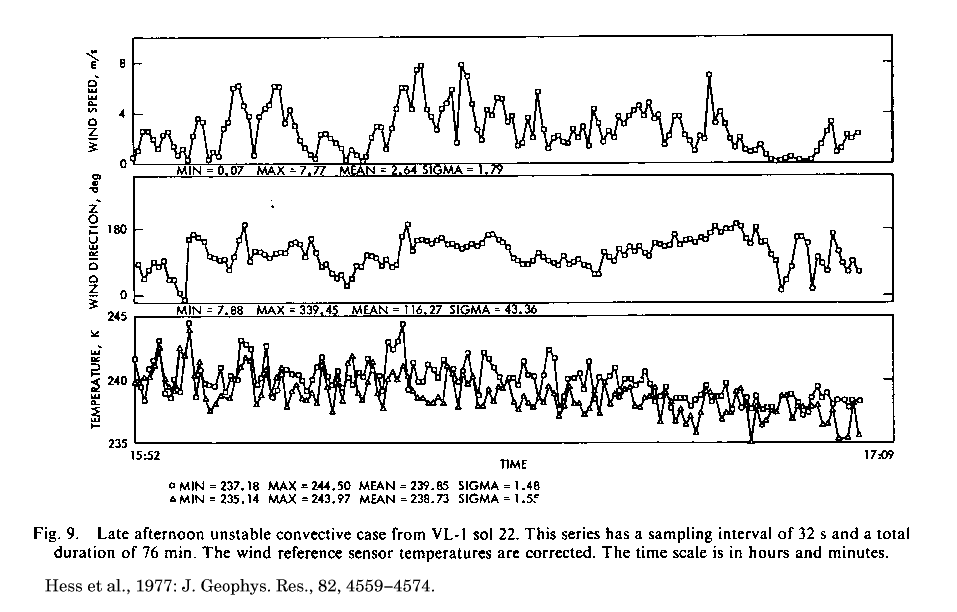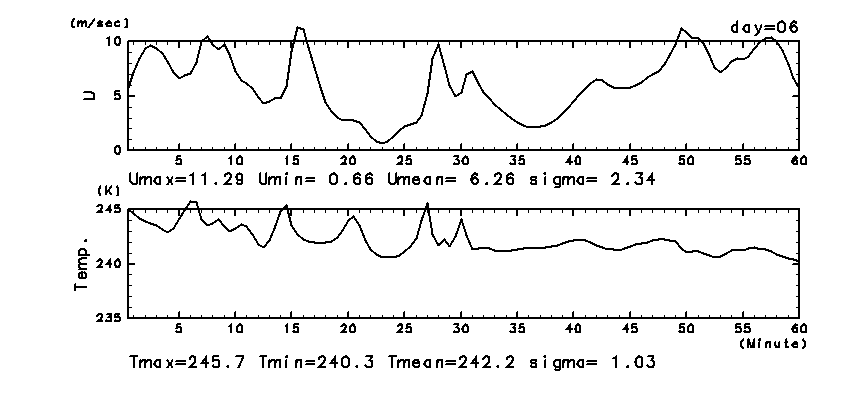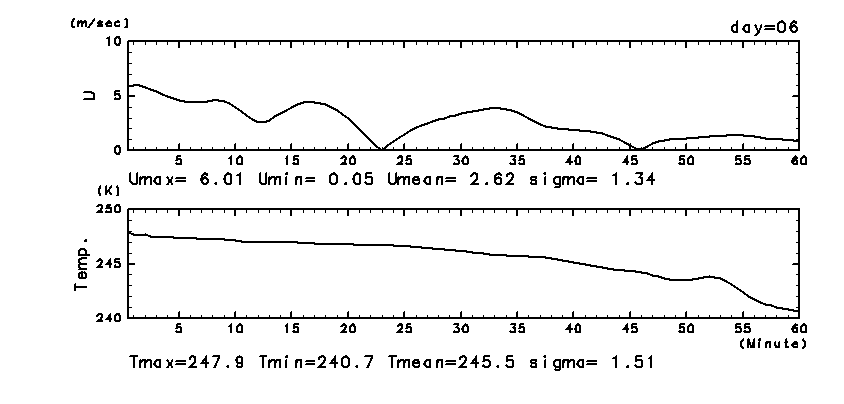|
5.a. Comparison with the observation results
|
The Viking landers, the Mars probes, observed
wind velocity and atmospheric temperature
at the height of 1.6 m.
Since the lowest level of the numerical model
utilized in the present study
is located at about the height of 1.5 m,
we can directly compare
the wind and temperature data obtained
at the lowest level of our model
with those from the Viking observation.
In the followings,
the numerical results of our study
are compared with the data of
horizontal wind velocity and temperature
of Viking 1 Lander
( Hess et al., 1977,
Fig.9),
which
(Hess et al., 1977)
argues are associated with thermal convection.
Figure 14a shows the time series of
horizontal wind speed, wind direction and surface temperature
observed at the site of the Viking 1 Lander from LT = 15:52 to
17:09 of 22nd sol after landing (Ls ˜ 110°).
The atmospheric visible dust opacity observed at the same time is
about 0.4 (Pollack et
al., 1979), which is a value between those adopted in
the dust-free case and the dusty case of our numerical
simulation.
In the observed time series of wind velocity,
there appear two components of wind fluctuations
overlapping to each other;
one has an amplitude of about 5 m sec-1
and a period from several to ten-several minutes,
and the other has an amplitude of about 3
m sec-1 and
a period from 1 to 2 minutes.
Also in the temperature field,
there appear two components fluctuating
with the time scales similar to those wind variations,
whose magnitudes are about 3 K.
The temperature and wind fluctuations with the relatively longer
time scale in Figure 14a resemble
those simulated by our model under the clear sky condition
(Figure 14b).
They may be associated with the passages of roots of plumes
ascending from the lower levels or the convective circulations
ranging all over the convective layer.
On the other hands, the observed fluctuations with the shorter
time scale do not have the corresponding ones in our
calculation results.
They are considered to be associated with subgrid scale features
smaller than 100 m, for examples, thermal or forced turbulence
in the thermal conduction layer or transition layer which is
parameterized in our model.
These results suggest that our numerical model successfully
represent the major features of thermal convection driven by
radiative forcing in the real Martian atmosphere
except for the small scale turbulent structures.
Conversely, we can say that the fluctuations with the time scale
from a few to ten minutes in the observed data are associated
with the km-size thermal convection driven by radiation
In the dusty case of our numerical simulation
(Figure 14c), there do not appear any
fluctuations which resemble those in the observed data.
It may be possible to attribute the reason to the difference of
atmospheric dust opacity.
We may suppose that the amount of dust is larger than that
of the Viking observation, and hence
the atmospheric stability is enhanced and
convective activity is suppressed.
Actually, the activity of thermal convection
of the dusty case of our numerical simulation
almost terminates by the period shown here
(see also Figure 13).

|
|
Figure 14a:
Time series of wind velocity, wind direction and
atmospheric temperature observed by Viking 1 Lander.
from LT = 15:52 to 17:09
in sol 22nd after the landing
(Hess et
al., 1977, Figure 9).
The sampling time interval is 32 seconds.
|

|
|
Figure 14b:
Time series of wind velocity and atmospheric temperature
calculated by the 2D numerical model from LT = 16:00 to 17:00
of the sixth day of the dust-free case.
The sampling time interval is 30 seconds.
|

|
|
Figure 14c:
Time series of wind velocity and atmospheric temperature
calculated by the 2D numerical model from LT = 16:00 to 17:00
of the sixth day of the dusty case.
The sampling time interval is 30 seconds.
Note that the range of vertical axis for temperature is different from
that in Figure 14a and Figure 14b.
|
|